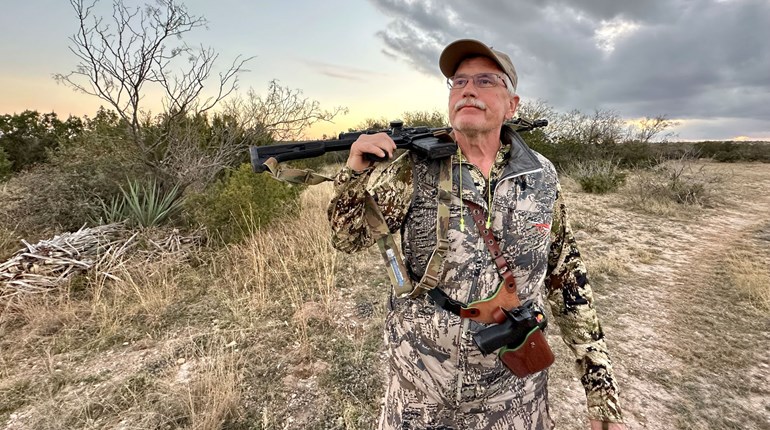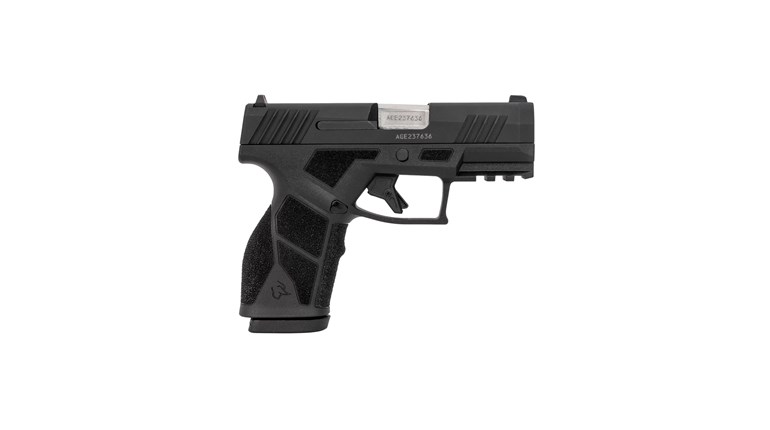Hog hunting’s become darned trendy, with various clans of television “hoggers” chasing down wild porkers with packs of yelping dogs, while celebrities shoot up Texas hogs from helicopters.
All well and good. But what if you’re simply a deer hunter who’d like to try his or her hand at wild hogs? What’s it going to take for you to get into the hog hunting game?
The good news is, you don’t need a helicopter. If you are already a deer hunter, you probably have most of what you need to take on feral pigs. With that in mind, here’s a quick introduction to the how and why of hunting what is quickly becoming among America’s top game animals.
Hog Senses
As a good friend of mine once told me, just before he sent me off in search of some hogs on his East Texas deer lease, “Remember, these hogs have great noses. Decent ears, too. But they can’t see worth a lick, especially if you stay in the shadows under the trees or behind some cover. Use the wind, get close, take your time.”
Advice I’ve used ever since.
Scientists will tell you that hogs have a keener sense of smell than dogs. And when they smell you, they head in the other direction at top speed. They can hear OK, too, in my experience, and if something doesn’t sound right, they start moving out.
Their eyes are their weak spot, and you can use that to your advantage. However, it’s not as if they are blind. I’ve been busted by hogs at 100 yards and less. They didn’t hang around to give me a shot!
Beyond 100 yards, my observation is they can see general objects, especially moving objects, and while they don’t seem able to recognize exactly what they are seeing, anything different will cause them to drift in the opposite direction.
But if you use available cover, duck into shade and shadows, hogs have a very difficult time seeing you, and you can get considerably closer than you could to, say, a white-tailed deer.
Food and Cover
Hogs require what any wild animal needs to live: food, water and cover. Hogs, though, don’t need a specific food source. They’ll eat acorns and watermelons, tubers and grubs, row crops, carrion and the odd live fawn if they happen upon one. And a whole lot of other things!
That said, agricultural fields are often prime feeding areas for hogs, especially fields surrounded by thick cover. Hogs like to head for these fields first thing to begin an evening’s feeding, and often return for a last snack in the early mornings on their way back to bedding areas.
Hogs do need water, plenty of it. They like to get a big, long drink before they begin feeding and after they’ve eaten. That makes setting up at watering holes very productive.
Hogs love to wallow in mud, too, so swamps are hog magnets. Look for hog wallows along streams and in low spots, too. Scout out trails and corridors they use to get to these wallows and ambush accordingly.
Guns
If you have a center-fire rifle or shotgun that will take down a deer, you have a firearm that will most likely do the job for hog hunting.
Now, there are those who insist that a hog gun should be .30 caliber or larger. That argument is advanced for good reason: Stout and compact, hogs can be very difficult to kill. They are tough-skinned animals, and that skin is stretched over a layer of solid fat. Boars also have a shield, a “vest”of hard cartilage over the chest and shoulder areas that can exceed an inch in thickness. Heavy muscles and rock-hard bones complete a hog’s physique.
A bullet has to get through some or all of that before it gets to a hog’s vitals, and a bullet in the .30 caliber and better range can have an easier time of it.
At the same time, plenty of hogs have been killed with rifles chambered in .243 Win., 6 mm, and .270s. In fact, a whole lot of hog hunters use the popular .223 Rem./5.56 mm AR rifles to hunt hogs, with good results.
It’s all about placement. A .223 in the heart-lung area, with good ammunition, can drop a 200-pound hog where it stands. A .308 Win. in the rump of the same hog will result in a dead pig—after it runs a mile and ends up in the thickest brush it can find.
Optics
If your deer-hunting rig is outfitted with a scope or red-dot optic, you are likely good to go.
Want to buy an optic specifically for your hog hunting? I prefer some flexibility. My hog hunting often has me in and moving through some pretty thick cover. But I’ve also taken hogs out to 200 yards.
So my top hog-hunting optics have variable power settings, usually in the 1-4 or 1-5 power range. One of my favorites is Leupold’s VX-R 1.25- 4 scope. I’ve used it on AR’s and bolt actions for hog hunting, and it is currently mounted on my new slug gun pig rig. Close in or in heavy cover, the VX-R’s low power setting puts me on hogs fast. But I can still reach out a couple hundred yards at higher power. The illuminated FireDot reticle is a real help in low-light conditions when the crosshair can get lost on a black or mud-covered hog.
Many hunters I know who use ARs for hogs prefer holographic or red-dot type optics. They tend to prefer ambush hunting, up close and personal, with multiple shots being fired. So a low-power optic with a wide field of view makes a lot of sense.
Ammunition
Given how a hog’s body is put together, you need a bullet that holds together while it punches through a hog’s shield and bone, and then expands quickly.
There are a lot of ammunition options that will do just that. Everything from Remington’s workhorse Core-Lokt rounds to Hornady’s offerings in the newer Superformance SST packages (using a polymer-tipped bullet with Interlocked heavy jacket), to a number of different rounds featuring the Barnes TSX bullet.
Both Winchester and Remington have even gone into the hog-ammo business with their new Winchester Razorback XT and Remington Hog Hammer offerings, respectively, in a variety of center-fire calibers. Constructed of gilding metal, the one-piece bullets in these rounds are designed to pierce shields and bone, and then expand quickly.
Stay away from fast-expanding varmint-type loads. They’ll get a slab-sided pig bloody and darned upset, but won’t penetrate deep enough to put him down.
Most any hunting slug will do a fine job on hogs, especially the new generations of copper-based slugs that peel back as they open and create deep wound channels.
Night Lights
When it gets hot, like Texas-in-the-summer hot, hogs usually go nocturnal. If you live in a state where it’s legal, night hunting can be very productive and a lot of fun.
Now, you can spend thousands and thousands of dollars on night-vision gear and scopes. A number of hardcore hog hunters have gone this route.
But if you are going to hunt hogs at night and you’d prefer to stay out of bankruptcy, consider one of the many L.E.D. lights that attach to a rifle or scope. There are at least a dozen such lights on the market I know of, and I have tried out several. My preference is for one with 300 lumens of lighting power that can reach out a good 100 yards or better.
There are also a number of motion-sensor lights that are placed near a feeder or watering hole, and turn on when a hog (or other animal) gets close.
Hunting Methods
Stands near feeders. Lots of deer hunters, especially in the South and Southeast, already have this set up in place. Lay down some extra corn. Douse the area with some sweet stuff —hogs love fruit-flavored sugary-drink concoctions—set up and wait. Stands near water work well, too, as do those set up along the edges of ag fields.
Ground blinds can also can be quite effective, but wind is a larger factor here. Set up downwind of feeding areas and travel routes. Scent masking or eliminating products can be a big help.
Spot-and-stalk-hog hunting in popular in places like central coastal California where the open vistas and steep, hilly terrain provide good opportunities to spot singles and groups of hogs at distance. Then you try to cut them off! You need good binoculars, decent boots and some leg muscle, but it’s often very fun hunting.
Still hunting in areas with good numbers of hogs, walking logging trails and ranch roads can be an effective way to jump a few pigs. Early mornings and an hour before dark are best bets.
Where to Hunt?
Estimates put the total number of wild hogs in this country at 5 million animals—and literally growing by the day. The Southeastern Cooperative Wildlife Disease Study (SCWDS) at the University of Georgia's School of Veterinary Medicine reports that 36 states currently have established populations of wild or feral hogs.
“The term ‘established’ means that these animals in those states are found in several populations, have been present for several years, and there is evidence of reproduction,” says Dr. Jack Mayer, one of the country’s top experts in feral hogs and a scientist at the Savannah River National Laboratory.
SCWDS maintains the National Feral Swine Mapping System, an Internet-based national map of reported sightings and verifications of wild hogs.
In many Southern and Southeastern states, wildlife management units can provide good public hog-hunting opportunities. Check the hunting regulations thoroughly before you go, though. Some of these wildlife units have special hog-only hunts, while others allow you to take a hog only when a specific hunting season is already on-going, like spring turkey or fall small game. Hog hunting at other times of the year, in such units, is illegal.
Your state game agency may have information on hogs, too.
And just ask around! Wild hogs are popping up in many parts of the nation, long before game agency and other wildlife officials are aware of these new populations.
Last year, for example, I discovered there were wild hogs in the high-desert and sage brush of Eastern Oregon, near Burns, even though that state’s game agency and the National Feral Swine Mapping System showed no hogs here. Yet, locals told me they have had a growing population of wild hogs in place for at least five years. The hogs were becoming increasingly destructive to ranchers and farmers, and I was welcome to hunt as many as I’d like.





































